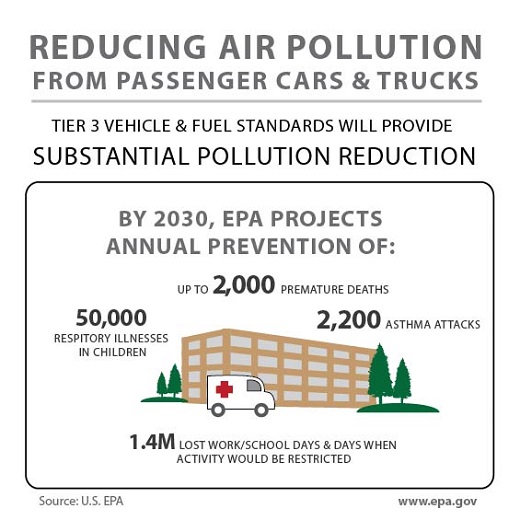
Ed. note: This is cross-posted from the EPA Connect blog. See the original post here.
Today I’m thrilled to announce EPA’s new clean fuel and vehicle standards that are a win for public health, a win for our environment, and a win for our wallets. These “Tier 3” emission standards for cars and gasoline will significantly reduce harmful emissions, prevent thousands of premature deaths and illnesses, and encourage innovation and technological improvements in the cars and trucks we drive.
By reducing gasoline sulfur levels by more than 60% (down from 30 to 10 parts per million (ppm) in 2017), vehicle emission control technologies can perform more efficiently, both on existing vehicles and on new ones. The new Tier 3 standards will also slash a range of harmful pollutants that can cause premature death and respiratory illnesses. They will reduce smog-forming volatile organic compounds (VOC) and nitrogen oxides (NOX) by 80%, establish a 70% tighter particulate matter standard (PM2.5), and virtually eliminate fuel vapor emissions.

Tier 3 builds on a broader array of practical and achievable cleaner fuel and vehicle standards that cut carbon pollution that contributes to climate change, clean the air we breathe, strengthen energy security, and save families money at the pump. They build on already established fuel efficiency standards that by 2025 will save American families more than $8,000 at the pump over their vehicle’s lifetime.
Cutting tailpipe pollution and reducing harmful emissions along the streets that run through our neighborhoods and near our schools will deliver immediate and lasting public health benefits for communities across the country. By 2030, EPA estimates that Tier 3 standards will prevent up to 2,000 premature deaths, 50,000 cases of respiratory ailments in children, 2,200 hospital admissions and asthma-related emergency room visits, and 1.4 million lost school and work days every year.

And these standards are good for all Americans. Many of the communities disproportionally overburdened by congested roadways and traffic pollution are lower income and urban communities that live nearby.
The benefits clearly outweigh the costs. Using a proven approach that looks at cars and fuels together as an integrated system, the standards will return up to $13 in health benefits for every $1 spent to meet them. Once the standards are fully in place, the average cost to refineries is less than one cent per gallon of gasoline. That’s a small price to pay for cleaner air and more livable communities across America.
As with all of our work, in developing these standards we engaged in extensive outreach to stakeholders. We spoke to the auto industry, health groups, states, environmental groups, and more. We held public meetings and received more than 200,000 public comments on our proposed rule. That’s why these standards are practical, commonsense, and are both cost effective and protective of public health.
The bottom line: these standards are a win-win-win for our families’ health, for the planet, and for our pocketbooks. Today marks a big step forward towards ensuring a cleaner and healthier environment for all.


